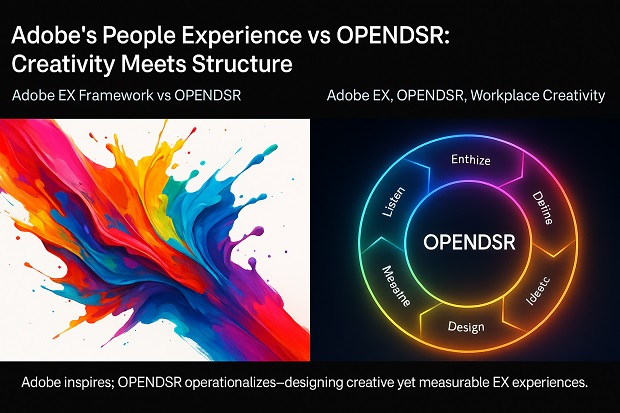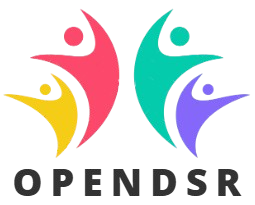
Adobe’s People Experience vs OPENDSR: Creativity Meets Structure
Adobe’s People Experience vs OPENDSR: Creativity Meets Structure
Introduction: When Creativity Becomes the Culture
Adobe has long been recognized not just for its products—but for its people philosophy.
Through its “People Experience” framework, Adobe reimagined HR as a creative function, blending art, empathy, and autonomy to drive innovation. From the “Check-In” system that replaced performance reviews to its open feedback culture, Adobe proved that creativity is not just a product capability—it’s a human experience capability.
But as organizations scale, creativity alone isn’t enough. The challenge becomes:
“How do you keep creativity alive while ensuring structure, measurement, and adaptability?”
That’s where OPENDSR enters the conversation—a human-centered, design-led operating framework that gives organizations a repeatable rhythm for transforming experiences with empathy and precision.
This article explores how Adobe’s People Experience and OPENDSR together redefine the modern employee experience—from moments of inspiration to systems of empathy.
1. Two Frameworks, One Intention
Both Adobe and OPENDSR share a common goal: to humanize work.
But they approach it differently—one as a creative ecosystem, the other as a design operating system.
Aspect Adobe People Experience OPENDSR Type Organizational Philosophy and EX Model Human-Centered Experience (HCX) Operating Framework Core Focus Creativity, empowerment, and autonomy Empathy, adaptability, and design governance Foundation Design-led HR and trust-based leadership Behavioral intelligence, design systems, continuous feedback Approach Empower employees through creativity and ownership Enable organizations to systematize empathy and design Primary Output Engaged, innovative workforce Adaptive, measurable experience transformation Visual Identity Creative freedom and color Systematic empathy and structure
Adobe’s model inspires; OPENDSR operationalizes.
Together, they show how creativity can be transformed into a measurable, evolving experience system.
2. The Essence of Adobe’s People Experience
Adobe’s People Experience (PX) philosophy emerged from a desire to replace control with creativity.
It rests on three foundational beliefs:
-
People are creators by nature.
Every employee, not just designers, can shape better experiences for customers and colleagues. -
Feedback fuels growth.
The company abolished annual performance reviews and replaced them with continuous “Check-Ins” — regular, open-ended conversations between managers and employees. -
Flexibility unlocks performance.
By trusting employees with freedom over how, when, and where they work, Adobe nurtures a culture of creative autonomy.
Key Components of Adobe’s People Experience Model Component Description Example Empowerment Employees own their development journey. Check-In model replaces top-down performance appraisals. Creativity Encourage risk-taking and ideation. Hackathons, innovation funds, and design sprints. Belonging Inclusion as a design principle. DEI embedded in hiring, leadership, and storytelling. Purpose Connect work to human impact. Brand narrative links Adobe tools to global creativity. Flexibility Hybrid and personalized work structures. Freedom to define workflows and routines.
Adobe’s PX model celebrates human creativity, not as a perk but as an operating principle. Yet, this very freedom poses an interesting question:
“How do you sustain creativity at scale—without losing coherence or direction?”
That’s where OPENDSR’s structure becomes essential.
3. The OPENDSR Framework: From Inspiration to Implementation
OPENDSR (Observe, Prioritize, Envision, Navigate, Design, Systematize, Refine) is a seven-step operating cycle that helps organizations transform insights into measurable experiences.
Step Purpose Example in Practice 1. Observe Sense real-time signals across the organization. Capture creative friction, collaboration patterns, or burnout cues. 2. Prioritize Identify moments that matter most. Choose which creative blockages or cultural gaps to solve first. 3. Envision Co-create what the improved experience should look and feel like. Prototype a “creative rest week” or idea-lab ritual. 4. Navigate Map existing workflows and barriers. Identify where bureaucracy slows creative flow. 5. Design Prototype and test small interventions. Launch a peer-coaching circle for idea incubation. 6. Systematize Integrate what works into policy and culture. Add the peer-coaching model into onboarding or OKRs. 7. Refine Collect real-time feedback for continuous evolution. Use sentiment analysis to evolve the practice over time.
OPENDSR turns creativity into a repeatable system of empathy and improvement.
It ensures that inspiration doesn’t fade into chaos—it evolves into culture.
4. Comparative Lens: Creativity vs Structure Dimension Adobe People Experience OPENDSR Framework Combined Value Core Philosophy Freedom and creativity Structure and adaptability Creative discipline Experience Design Approach Cultural and inspirational Operational and systemic Integrated design culture Feedback Mechanism Conversational (Check-In) Continuous (Real-Time Loops) Dynamic feedback architecture Scalability People-led innovation System-led iteration Culture that scales with structure Measurement Qualitative experience Quantitative and qualitative metrics Balanced scorecard Outcome Creative engagement Adaptive intelligence Emotionally intelligent organization 5. Adobe’s Strength: The Art of Trust and Autonomy
Adobe’s most profound success has been trust as strategy.
-
Managers shifted from evaluators to enablers.
-
Employees gained autonomy to define success.
-
HR became an experience studio rather than a compliance unit.
Illustrative Practice: The Check-In Model
Instead of annual ratings:
-
Managers hold ongoing, informal discussions.
-
Employees receive continuous developmental feedback.
-
The result: higher engagement, reduced attrition, and psychological safety.
Cultural DNA
Adobe encourages:
-
Failing fast, learning faster
-
Purposeful creativity
-
Design-led leadership
This creative ethos turned Adobe into one of the world’s most admired companies, not just for its products but for its people experience innovation.
Yet, with freedom comes the challenge of alignment and accountability—which OPENDSR elegantly resolves.
6. OPENDSR’s Strength: Turning Freedom into Flow
Where Adobe’s philosophy thrives on freedom, OPENDSR ensures freedom has flow.
1. Real-Time Intelligence
Empowers organizations to observe emotional signals (stress, excitement, motivation) as they occur—turning culture into a measurable ecosystem.
2. Human-Centered Governance
Defines roles like:
-
EX Owner – accountable for moments that matter.
-
HCX Data Steward – bridges analytics and empathy.
-
Moment Designer – transforms insights into interventions.
3. Feedback Integration
Where Adobe listens through conversation, OPENDSR loops that feedback into structural design—policies, journeys, and workflows.
4. Continuous Refinement
Each creative idea becomes a living prototype—tested, measured, and evolved.
OPENDSR ensures that creative energy translates into operational sustainability.
7. Case Example: When Creativity Meets Structure
Scenario:
An Adobe-like organization notices burnout among its creative teams during product launch cycles.
Stage Adobe PX Approach OPENDSR Activation Observation Check-Ins reveal fatigue and emotional drain. Observe phase captures patterns of workload imbalance. Insight Employees crave creative freedom and clarity. Prioritize moments of creative recovery and focus. Design Introduce “Recharge Fridays” for free exploration. Prototype structured 90-day rhythm balancing focus, freedom, feedback. Systemization Embed flexible schedules into leadership norms. Integrate the rhythm into governance and performance loops.
Result:
Creativity is no longer episodic—it becomes cyclical, measurable, and sustainable.
8. Table: Framework Capability Comparison Capability Adobe PX OPENDSR Best Use Innovation Culture High (Creative empowerment) Moderate (Systematized innovation) Adobe Measurement & Feedback Medium (Check-Ins, surveys) High (Real-time loops) OPENDSR Scalability Medium High OPENDSR Empathy Integration High (Human-centric) Very High (Empathy-led) OPENDSR Governance Light-touch Structured roles OPENDSR Design Thinking Application High Institutionalized OPENDSR Employee Ownership High Balanced with governance Both 9. Philosophical Bridge: From Art to Architecture
Adobe’s People Experience represents the art of work—unleashing creativity, autonomy, and human connection.
OPENDSR represents the architecture of work—building repeatable systems to sustain that creativity.
Together, they form a unified philosophy:
“Creativity without structure is chaos. Structure without creativity is compliance. Together, they create culture.”
10. The Emotional Core of Both Systems
Both models share an emotional truth: Humans seek meaning, not just management.
Emotional Driver Adobe PX Expression OPENDSR Expression Autonomy Creative freedom Design participation Belonging Inclusive culture Empathy-driven loops Mastery Continuous learning Skill validation and HCX proficiency Purpose Connect creativity to impact Align design to organizational purpose Flow Creative rhythm Adaptive rhythm
This alignment between emotional energy and operational rhythm defines the future of EX leadership.
11. Leadership Insights
-
Adobe Leaders are creative catalysts.
-
OPENDSR Leaders are experience architects.
Both must evolve into HCX Leaders—those who balance empathy with evidence, art with analysis, and innovation with integration.
Leadership Reflection Questions
-
How does our system reward creativity beyond productivity?
-
Are our experience metrics measuring energy or just output?
-
Do our leaders design experiences, or merely manage them?
-
Where can structure amplify—not stifle—human imagination?
12. The Future: Creative Systems and Human-Centered Intelligence
The next generation of experience platforms will blend:
-
Adobe’s Creative DNA → Emotional design and trust.
-
OPENDSR’s Operational DNA → Empathy-led intelligence and structure.
This fusion gives rise to Adaptive EX Systems, where:
-
Data feels human,
-
Feedback becomes design,
-
Creativity flows continuously.
Imagine a workplace where every project, policy, and ritual is both a creative canvas and a structured feedback loop—that’s the Adobe + OPENDSR vision.
13. Summary Comparison Table Dimension Adobe People Experience OPENDSR Framework Combined Future Model Foundation Creativity & Autonomy Empathy & Adaptability Human-Centered Creativity Focus Empowerment & Inspiration Design & Governance Inspired System Thinking Measurement Feedback and Check-Ins Real-time Design Loops Continuous Emotional Intelligence Cultural Impact Innovation culture Adaptive culture Learning culture Output Engaged employees Evolving experiences Purpose-driven, scalable EX Visual Metaphor Color splash (art) Process wheel (architecture) Creative system in motion Conclusion: Creativity Meets Structure, Emotion Meets Evidence
Adobe showed the world that creativity belongs in every cubicle, not just design studios.
OPENDSR shows the world how to make that creativity measurable, sustainable, and humanly adaptive.
Together, they mark the next evolution in Employee Experience:
from creative intention to operational empathy.
“Adobe inspires. OPENDSR operationalizes. Together, they design experiences that think, feel, and evolve.”








